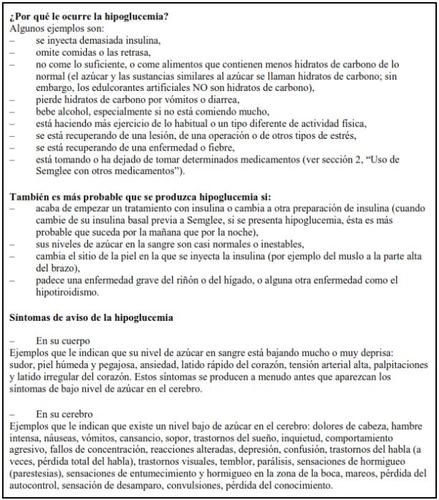

СЕМГЛІ 100 ОД/МЛ розчин для ін'єкцій у попередньо заповненому шприц-ручці


Інструкція із застосування СЕМГЛІ 100 ОД/МЛ розчин для ін'єкцій у попередньо заповненому шприц-ручці
Введення
Опис препарату: інформація для користувача
Semglee 100 одиниць/мл розчин для ін'єкцій у попередньо заповненому стилусі
інсулін гларгін
Цей лікарський засіб підлягає додатковому моніторингу, що полегшить виявлення нової інформації про його безпеку. Ви можете допомогти, повідомляючи про будь-які побічні ефекти, які ви можете мати. Остання частина розділу 4 містить інформацію про те, як повідомляти про ці побічні ефекти.
Прочитайте уважно весь опис препарату перед тим, як почати використовувати цей лікарський засіб, оскільки він містить важливу інформацію для вас.
- Збережіть цей опис препарату, оскільки вам може знадобитися знову прочитати його.
- Якщо у вас є якісь питання, проконсультуйтеся з вашим лікарем, фармацевтом або медсестрою.
- Цей лікарський засіб призначений тільки вам, і не слід давати його іншим людям, навіть якщо вони мають такі самі симптоми, як і ви, оскільки це може їм нашкодити.
- Якщо ви відчуваєте побічні ефекти, проконсультуйтеся з вашим лікарем або фармацевтом, навіть якщо це побічні ефекти, які не вказані в цьому описі препарату. Див. розділ 4.
Зміст опису препарату
- Що таке Semglee і для чого він використовується
- Що вам потрібно знати перед тим, як почати використовувати Semglee
- Як використовувати Semglee
- Можливі побічні ефекти
- Зберігання Semglee
- Зміст упаковки та додаткова інформація
1. Що таке Semglee і для чого він використовується
Semglee містить інсулін гларгін. Це модифікований інсулін, дуже подібний до людського інсуліну.
Semglee використовується для лікування цукрового діабету у дорослих, підлітків і дітей від 2 років.
Цукровий діабет - це захворювання, при якому ваш організм не виробляє достатньо інсуліну для контролю рівня цукру в крові. Інсулін гларгін має тривалу і постійну дію щодо зниження рівня цукру в крові.
2. Що вам потрібно знати перед тим, як почати використовувати Semglee
Не використовувати Semglee
- якщо ви алергічні на інсулін гларгін або на будь-які інші компоненти цього лікарського засобу (перелічені в розділі 6).
Попередження та обережність
Semglee у попередньо заповненому стилусі підходить тільки для підшкірних ін'єкцій. Проконсультуйтеся з вашим лікарем, якщо вам потрібно вводити інсулін іншим методом.
Проконсультуйтеся з вашим лікарем, фармацевтом або медсестрою перед тим, як почати використовувати Semglee.
Суворо дотримуйтесь інструкцій щодо дозування, контролю (аналізів крові та сечі), дієти та фізичної активності (фізичної праці та вправ), а також техніки ін'єкцій, які ви встановили з вашим лікарем.
Якщо ваш рівень цукру в крові занадто низький (гіпоглікемія), слідуйте інструкціям щодо гіпоглікемії (див. рамку в кінці цього опису препарату).
Подорожі
Перед тим, як вирушити в подорож, проконсультуйтеся з вашим лікарем. Можливо, вам потрібно буде проконсультуватися щодо:
- доступності вашого інсуліну в країні, яку ви плануєте відвідати,
- резервів інсуліну, голок тощо,
- правильного зберігання інсуліну під час подорожі,
- графіку прийому їжі та інсуліну під час подорожі,
- можливих ефектів зміни часових поясів,
- можливих нових ризиків для здоров'я в країнах, які ви плануєте відвідати,
- того, що вам потрібно робити в ситуаціях нагальної потреби, коли ви почуваєтеся погано або захворієте.
Хвороби та травми
Управління вашим цукровим діабетом може потребувати особливої уваги в наступних ситуаціях (наприклад, корекції дози інсуліну, аналізів крові та сечі):
- Якщо ви хворієте або маєте важку травму, ваш рівень цукру в крові може підвищитися (гіперглікемія).
- Якщо ви не їсте достатньо, ваш рівень цукру в крові може знизитися занадто низько (гіпоглікемія).
У більшості випадків вам потрібно буде проконсультуватися з лікарем. Переконайтеся, що ви негайно проконсультуєтеся з лікарем.
Якщо у вас цукровий діабет 1-го типу (діабет, залежний від інсуліну), не припиняйте вводити інсулін і не припиняйте приймати достатню кількість вуглеводів. Завжди повідомляйте людям, які займаються вашим доглядом або лікуванням, що вам потрібно інсулін.
Лікування інсуліном може викликати вироблення вашим організмом антитіл до інсуліну (речовин, які діють проти інсуліну). Однак лише в дуже рідких випадках вам потрібно буде змінити дозу інсуліну.
Деякі пацієнти з цукровим діабетом 2-го типу з тривалою історією захворювання та попереднім інфарктом міокарда або інсультом, які були behandлені піоглітазоном (оральним антидіабетичним засобом, використовуваним для лікування цукрового діабету 2-го типу) та інсуліном, мали розвиток серцевої недостатності. Повідомте вашому лікареві якнайшвидше, якщо ви відчуваєте симптоми серцевої недостатності, такі як незвичайна короткість дыхання або швидке збільшення ваги або локалізована набряклість (едем).
Діти
Немає досвіду використання Semglee у дітей молодших 2 років.
Використання Semglee з іншими лікарськими засобами
Деякі лікарські засоби можуть викликати зміни рівня цукру в крові (збільшення, зниження або обидва, залежно від ситуації). У кожному випадку може знадобитися корекція дози інсуліну для уникнення занадто низьких або занадто високих рівнів цукру в крові. Будьте обережні, коли починаєте приймати інший лікарський засіб, а також коли припиняєте його приймати.
Повідомте вашому лікареві або фармацевту, якщо ви приймаєте, нещодавно приймали або можете приймати інший лікарський засіб. Спитайте вашого лікаря, перш ніж приймати лікарський засіб, чи може він вплинути на рівень цукру в вашій крові, а також які заходи вам потрібно вжити в цьому випадку.
Серед лікарських засобів, які можуть викликати зниження рівня цукру в крові (гіпоглікемію), є:
- всі інші лікарські засоби для лікування цукрового діабету,
- інгібітори ангіотензинперетворюючого ферменту (АПФ) (використовувані для лікування деяких захворювань серця або підвищеного артеріального тиску),
- дісопірамід (використовуваний для лікування деяких захворювань серця),
- флуоксетин (використовуваний для лікування депресії),
- фібрати (використовувані для зниження рівня ліпідів в крові),
- інгібітори моноамінооксидази (МАО) (використовувані для лікування депресії),
- пентоксифілін, пропоксифен, саліцілати (наприклад, ацетилсаліцилова кислота, використовувана для полегшення болю та зниження температури),
- антібіотики групи сульфаніламідів.
Серед лікарських засобів, які можуть викликати підвищення рівня цукру в крові (гіперглікемію), є:
- кортикостероїди (наприклад, "кортизон", використовуваний для лікування запалення),
- даназол (лікарський засіб, який діє на овуляцію),
- діазоксид (використовуваний для лікування підвищеного артеріального тиску),
- діуретики (використовувані для лікування підвищеного артеріального тиску або надмірної ретенції рідини),
- глюкагон (панкреатичний гормон, використовуваний для лікування гіпоглікемії),
- ізоніазид (використовуваний для лікування туберкульозу),
- естрогени та прогестагени (наприклад, у контрацептивних таблетках, використовуваних для контролю над народжуваністю),
- похідні фенотіазину (використовувані для лікування психіатричних захворювань),
- соматотропін (гормон росту),
- симпатоміметичні лікарські засоби (наприклад, адреналін або салбутамол, тербуталін для лікування астми),
- тиреоїдні гормони (використовувані для лікування порушення функції щитоподібної залози),
- атипічні антипсихотичні лікарські засоби (наприклад, клозапін, оланзапін),
- інгібітори протеази (використовувані для лікування ВІЛ-інфекції).
Ваш рівень цукру в крові може підвищитися або знизитися, якщо ви приймаєте:
- бета-блокатори (використовувані для лікування підвищеного артеріального тиску),
- клонідин (використовуваний для лікування підвищеного артеріального тиску),
- солі літію (використовувані для лікування психіатричних захворювань).
Пентамідин (використовуваний для лікування деяких інфекцій, викликаних паразитами) може викликати гіпоглікемію, яка іноді може бути слідована гіперглікемією.
Бета-блокатори, а також інші симпатоміметичні лікарські засоби (наприклад, клонідин, гуанетидин і резерпін) можуть зменшити або完全но придушити перші симптоми гіпоглікемії, які можуть допомогти вам розпізнати гіпоглікемію.
Якщо ви не впевнені, чи приймаєте ви якийсь із цих лікарських засобів, спитайте вашого лікаря або фармацевта.
Використання Semglee з алкоголем
Ваш рівень цукру в крові може підвищитися або знизитися, якщо ви споживаєте алкоголь.
Вагітність та лактація
Проконсультуйтеся з вашим лікарем або фармацевтом перед тим, як використовувати будь-який лікарський засіб.
Повідомте вашому лікареві, якщо ви плануєте завагітніти або якщо ви вже вагітні. Ваша доза інсуліну може потребувати корекції під час вагітності та після пологів. Особливо ретельний контроль над цукровим діабетом та профілактика гіпоглікемії важливі для здоров'я вашої дитини.
Якщо ви перебуваєте в періоді лактації, проконсультуйтеся з вашим лікарем, оскільки вам може знадобитися корекція дози інсуліну та дієти.
Водіння транспортних засобів та використання машин
Ваша здатність до концентрації уваги або реакції може бути знижена, якщо:
- у вас гіпоглікемія (низький рівень цукру в крові),
- у вас гіперглікемія (високий рівень цукру в крові),
- у вас проблеми з зором.
Будьте обережні щодо цього можливого ризику, враховуючи всі ситуації, які можуть бути причиною ризику для вас або інших (наприклад, водіння транспортного засобу або використання машин). Ви повинні попросити вашого лікаря порадити щодо здатності до водіння транспортних засобів, якщо:
- у вас часто повторюються епізоди гіпоглікемії,
- зменшилися або не з'являються перші симптоми гіпоглікемії, які можуть допомогти вам розпізнати гіпоглікемію.
Semglee містить натрій
Цей лікарський засіб містить менше 1 ммоль (23 мг) натрію на дозу, тобто він практично "не містить натрію".
3. Як використовувати Semglee
Слідуйте точно інструкціям щодо введення цього лікарського засобу, вказаним вашим лікарем. У разі сумнівів спитайте вашого лікаря або фармацевта.
Хоча Semglee містить той самий активний інгредієнт, що й інсулін гларгін 300 одиниць/мл, ці лікарські засоби не є взаємозамінними. Зміна лікування інсуліном на інше лікування потребує призначення лікаря, медичного нагляду та контролю рівня цукру в крові. Для більшої інформації проконсультуйтеся з вашим лікарем.
Доза
Відповідно до вашого способу життя та результатів аналізів рівня цукру (глюкози) в крові та попереднього лікування інсуліном, ваш лікар:
- визначить дозу Semglee, яку вам потрібно вводити кожен день і о якій годині,
- покаже, коли вам потрібно аналізувати рівень цукру в крові, а також чи потрібно проводити аналіз сечі,
- покаже, коли вам може знадобитися введення вищої або нижчої дози Semglee.
Semglee - це інсулін тривалої дії. Ваш лікар може призначити вам використовувати його в поєднанні з інсуліном короткої дії або з таблетками для лікування підвищення рівня цукру в крові.
Багато факторів можуть впливати на рівень цукру в вашій крові. Ви повинні знати ці фактори, оскільки це дозволить вам правильно реагувати на зміни рівня цукру в крові та запобігти його підвищенню або зниженню.
Для більшої інформації див. рамку в кінці цього опису препарату.
Використання в дітей та підлітках
Semglee можна використовувати в підлітках та дітях від 2 років. Використовуйте цей лікарський засіб так, як вам сказав ваш лікар.
Частота введення
Вам потрібно вводити ін'єкцію Semglee кожен день, завжди о тій самій годині.
Стилус Semglee вводить інсулін у збільшеннях по 1 одиниці до максимальної одноразової дози 80 одиниць.
Форма введення
Semglee вводиться під шкіру. НЕ вводіть Semglee в вену, оскільки це змінить його дію та може викликати гіпоглікемію.
Ваш лікар покаже вам, в яку область шкіри вам потрібно вводити Semglee. З кожною ін'єкцією ви повинні змінювати місце уколу всередині конкретної області шкіри, яку ви використовуєте.
Як керувати стилусом Semglee
Semglee у попередньо заповненому стилусі підходить тільки для підшкірних ін'єкцій. Проконсультуйтеся з вашим лікарем, якщо вам потрібно вводити інсулін іншим методом.
Уважно прочитайте "Інструкції з використання", включені в цей опис препарату. Ви повинні використовувати стилус так, як описано в цих Інструкціях з використання.
Перед кожним використанням вам потрібно вставити нову голку. Використовуйте тільки голки, сумісні зі стилусом Semglee (див. "Інструкції з використання").
Перед кожною ін'єкцією вам потрібно провести тест на безпеку.
Перегляньте картридж перед використанням стилуса. Не використовуйте Semglee, якщо ви бачите частинки всередині нього. Використовуйте Semglee тільки якщо розчин прозорий та безбарвний. Не агітуйте та не змішуйте перед використанням.
Для запобігання можливому передачі захворювань ніколи не діліться своїм стилусом з іншими людьми. Цей стилус призначений тільки для вашого використання.
Використовуйте завжди новий стилус, якщо ви помітили, що ваш контроль над рівнем цукру в крові погіршився без пояснення. Якщо ви вважаєте, що у вас є проблема зі стилусом Semglee, проконсультуйтеся з вашим лікарем, фармацевтом або медсестрою.
Порожні стилуси не повинні бути перезаповнені та повинні бути утилізовані безпечно.
Не використовуйте стилус Semglee, якщо він пошкоджений або не функціонує правильно (через механічні дефекти), його потрібно утилізувати та використовувати новий стилус Semglee.
Помилки з інсуліном
Ви повинні завжди перевірити етикетку інсуліну перед кожною ін'єкцією, щоб уникнути помилок між Semglee та іншими інсулінами.
Якщо ви використали більше Semglee, ніж потрібно
Якщо ви ввели занадто багато Semglee,ваш рівень цукру в крові може стати дуже низьким (гіпоглікемія). Перевіряйте ваш рівень цукру в крові часто. Загалом, для профілактики гіпоглікемії вам потрібно буде їсти більше та контролювати рівень цукру в крові. Для більшої інформації про лікування гіпоглікемії див. рамку в кінці цього опису препарату.
Якщо ви забули використовувати Semglee
Якщо ви забули прийняти дозу Semglee або якщо ви не ввели достатньо інсуліну, ваш рівень цукру в крові може підвищитися дуже сильно (гіперглікемія). Перевіряйте ваш рівень цукру в крові часто. Для більшої інформації про лікування гіперглікемії див. рамку в кінці цього опису препарату.
Не приймайте подвійну дозу для компенсації пропущених доз.
Якщо ви припините лікування Semglee
Це може викликати гіперглікемію (дуже високий рівень цукру в крові) та кетоацидоз (підвищення рівня кислот у крові, оскільки організм розкладає жири замість цукру). Не припиняйте лікування Semglee без консультації з вашим лікарем, він скаже вам, що вам потрібно зробити.
Якщо у вас є якісь інші питання щодо використання цього лікарського засобу, спитайте вашого лікаря, фармацевта або медсестри.
4. Можливі побічні ефекти
Як і всі лікарські засоби, Semglee може викликати побічні ефекти, хоча не всі люди їх відчувають.
Якщо ви помітите ознаки того, що ваш рівень цукру в крові занадто низький (гіпоглікемія),негайно вжите дії для підвищення рівня цукру в крові (див. рамку в кінці цього листка). Гіпоглікемія (низький рівень цукру в крові) може бути дуже серйозною і дуже часто трапляється під час лікування інсуліном (може вплинути на понад 1 з 10 осіб). Низький рівень цукру в крові означає, що в крові недостатньо цукру. Якщо ваш рівень цукру в крові занадто низький, ви можете втратити свідомість (зупинити серце). Серйозна гіпоглікемія може викликати пошкодження мозку і може бути потенційно смертельною. Для більшої інформації див. рамку в кінці цього листка.
Серйозні алергічні реакції(рідкісні, можуть вплинути на до 1 з 1000 осіб): ознаки можуть включати реакції шкіри в великому масштабі (виразка шкіри та свербіж по всьому тілу), сильне набрякання шкіри або слизових оболонок (ангіоедем), труднощі з диханням, зниження артеріального тиску з швидким серцебиттям і потінням. Серйозні алергічні реакції на інсулін можуть бути потенційно смертельними. Повідомте своєму лікареві негайно, якщо ви помітите ознаки серйозних алергічних реакцій.
Зміни шкіри в місці ін'єкції:
Якщо ви вводите інсулін занадто часто в одному місці, шкіра може зменшилася (ліпоатрофія, може вплинути на до 1 з 100 осіб) або загустіти (ліпогіпертрофія, може вплинути на до 1 з 10 осіб). Також можуть з'явитися підшкірні бугорки, викликані накопиченням білка, званого амілоїдом (кутанна амілоїдоз, частота якої невідома). Інсулін може не діяти дуже добре. Змінюйте місце ін'єкції з кожною ін'єкцією, щоб допомогти запобігти цим змінам шкіри.
Часті побічні ефекти(можуть вплинути на до 1 з 10 осіб)
- Побічні ефекти шкіри та алергічні реакції в місці ін'єкції
Ознаки можуть включати червоність, сильний біль при ін'єкції, свербіж, кропив'янку, набрякання або запалення. Ці реакції можуть поширитися навколо місця ін'єкції. Більшість легких реакцій на інсулін зникають звичайно за кілька днів або тижнів
- Побічні ефекти шкіри та алергічні реакції в місці ін'єкції
Ознаки можуть включати червоність, сильний біль при ін'єкції, свербіж, кропив'янку, набрякання або запалення. Ці реакції можуть поширитися навколо місця ін'єкції. Більшість легких реакцій на інсулін зникають звичайно за кілька днів або тижнів.
Рідкісні побічні ефекти(можуть вплинути на до 1 з 1000 осіб)
- Очні реакції
Значна зміна (поліпшення або погіршення) контролю рівня цукру в крові може тимчасово змінити ваш зір. Якщо ви страждаєте від проліферативної ретинопатії (захворювання очей, пов'язане з цукровим діабетом), серйозні гіпоглікемічні атаки можуть викликати тимчасову втрату зору.
- Загальні розлади
У рідкісних випадках лікування інсуліном може викликати також тимчасову ретенцію води в організмі, з набряканням гомілок і щиколоток.
Дуже рідкісні побічні ефекти(можуть вплинути на до 1 з 10 000 осіб)
У дуже рідкісних випадках може виникнути дисгевзія (розлади смаку) та міалгія (м'язеві болі).
Використання в дітей та підлітків
Загалом, побічні ефекти в дітей та підлітків у віці 18 років або молодших схожі на ті, що виникають у дорослих.
Більш часто повідомляються про реакції в місці ін'єкції (реакція в місці ін'єкції, біль в місці ін'єкції) та реакції шкіри (виразка, кропив'янка) у дітей чи підлітків у віці 18 років або молодших, ніж у дорослих.
Немає досвіду використання в дітей молодших 2 років.
Повідомлення про побічні ефекти
Якщо ви відчуваєте побічні ефекти, проконсультуйтеся з вашим лікарем або фармацевтом. Це включає можливі побічні ефекти, які не вказані в цьому листку. Також ви можете повідомити про них безпосередньо через національну систему повідомлення, включену до додатка V. Повідомляючи про побічні ефекти, ви можете допомогти надати більше інформації про безпеку цього лікарського засобу.
5. Зберігання Семглее
Тримайте цей лікарський засіб поза зоною видимості та доступу дітей.
Не використовуйте цей лікарський засіб після дати закінчення терміну зберігання, вказаної на упаковці та на етикетці піни після CAD/EXP. Дата закінчення терміну зберігання - останній день місяця, який вказано.
Піни, які не були використані
Зберігайте в холодильнику (між 2 °C та 8 °C). Не заморожуйте та не розміщуйте біля відділу морозильника або охолоджувача.
Тримайте піну, завантажену в зовнішню упаковку, для захисту від світла.
Піни в користуванні
Піну, завантажену в користуванні або для транспортування, слід зберігати протягом максимум 4 тижнів при температурі нижче 30 °C та захисту від прямого тепла чи світла. Не використовуйте після цього періоду часу. Піну в користуванні не слід зберігати в холодильнику.
Кришку піни слід повертати на місце після кожної ін'єкції для захисту від світла.
Видаліть голку після ін'єкції та збережіть піну без голки. Також переконайтеся, що видалити голку перед викиданням піни. Голки не слід повторно використовувати.
Лікарські засоби не слід викидати в каналізацію чи сміття. Спитайте свого фармацевта, як позбутися упаковок та лікарських засобів, які вам вже не потрібні. Таким чином, ви допоможете захистити навколишнє середовище.
6. Зміст упаковки та додаткова інформація
Склад Семглее
- Активний інгредієнт - інсулін гларгін. Кожен мл розчину містить 100 одиниць інсуліну гларгіна (еквівалентно 3,64 мг).
- Інші компоненти: хлорид цинку, метакрезол, гліцерол, гідроксид натрію (для регулювання pH) (див. розділ 2 "Семглее містить натрій"), хлоридна кислота (для регулювання pH) та вода для ін'єкцій.
Вигляд продукту та вміст упаковки
Семглее 100 одиниць/мл ін'єкційний розчин у попередньо наповненій піштучці - це прозорий безбарвний розчин.
Кожна піштучка містить 3 мл ін'єкційного розчину (еквівалентно 300 одиницям).
Семглее доступний у упаковках по 1, 3, 5 та 10 піштучок або мультиупаковці, що містить 2 коробки, кожна з яких містить 5 піштучок.
Можливо, що тільки деякі розміри упаковок будуть продаватися.
Уповноважений представник
Biosimilar Collaborations Ireland Limited
Юніт 35/36
Грейндж-Парад, Балдойл Індустріал Естейт,
Дублін 13
ДУБЛІН
Ірландія
D13 R20R
Виробник
Biosimilar Collaborations Ireland Limited
Блок Б, Кресент Білдінг, Сантрі Демезн
Дублін
D09 C6X8
Ірландія
Для отримання додаткової інформації про цей лікарський засіб зверніться до місцевого представника уповноваженого представника:
Бельгія/Бельгія/Бельгія Біокон Біологічні Бельгія БВ Тел: 0080008250910 | Литва Біосіміляр Коллаборації Ірландія Лімітед Тел: 0080008250910 |
Україна Біосіміляр Коллаборації Ірландія Лімітед Тел: 0080008250910 | Люксембург/Люксембург Біокон Біологічні Франція САС Тел: 0080008250910 |
Чехія Біокон Біологічні Німеччина ГмбХ Тел: 0080008250910 | Угорщина Біосіміляр Коллаборації Ірландія Лімітед Тел: 0080008250910 |
Данія Біокон Біологічні Фінляндія ОЙ Тел: 0080008250910 | Мальта Біосіміляр Коллаборації Ірландія Лімітед Тел: 0080008250910 |
Німеччина Біокон Біологічні Німеччина ГмбХ Тел: 0080008250910 | Нідерланди Біокон Біологічні Франція САС Тел: 0080008250910 |
Естонія Біосіміляр Коллаборації Ірландія Лімітед Тел: 0080008250910 | Норвегія Біокон Біологічні Фінляндія ОЙ Тел: +47 800 62 671 |
Греція Біокон Біологічні Греція МОНОПРОСОПІ І.К.Ε. Тел: 0080008250910 | Австрія Біокон Біологічні Німеччина ГмбХ Тел: 0080008250910 |
Іспанія Біокон Біологічні Іспанія СЛ Тел: 0080008250910 | Польща Біосіміляр Коллаборації Ірландія Лімітед Тел: 0080008250910 |
Франція Біокон Біологічні Франція САС Тел: 0080008250910 | Португалія Біокон Біологічні Іспанія СЛ Тел: 0080008250910 |
Хорватія Біокон Біологічні Німеччина ГмбХ Тел: 0080008250910 | Румунія Біосіміляр Коллаборації Ірландія Лімітед Тел: 0080008250910 |
Ірландія Біосіміляр Коллаборації Ірландія Лімітед Тел: 1800 777 794 | Словенія Біосіміляр Коллаборації Ірландія Лімітед Тел: 0080008250910 |
Ісландія Біокон Біологічні Фінляндія ОЙ Сімі: +345 8004316 | Словаччина Біокон Біологічні Німеччина ГмбХ Тел: 0080008250910 |
Італія Біокон Біологічні Іспанія СЛ Тел: 0080008250910 | Фінляндія Біокон Біологічні Фінляндія ОЙ Пух/Тел: 99980008250910 |
Кіпр Біосіміляр Коллаборації Ірландія Лімітед Тел: 0080008250910 | Швеція Біокон Біологічні Фінляндія ОЙ Тел: 0080008250910 |
Латвія Біосіміляр Коллаборації Ірландія Лімітед Тел: 0080008250910 |
Дата останнього перегляду цієї інструкції: {місяць РРРР}.
Інші джерела інформації
Детальна інформація про цей лікарський засіб доступна на сайті Європейського агентства з лікарських засобів: http://www.ema.europa.eu.
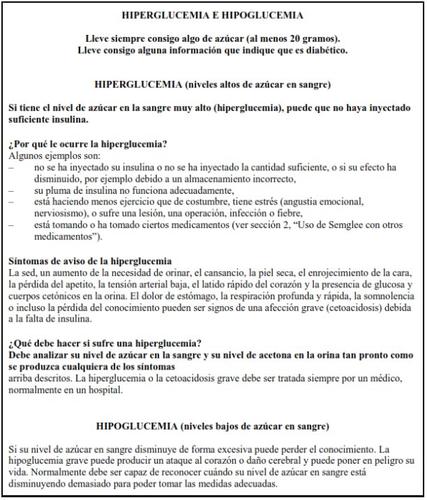
Семглее 100 одиниць/мл ін'єкційний розчин у попередньо наповненій піштучці. ІНСТРУКЦІЇ ЗАСТОСУВАННЯ
Читайте ці інструкції з застосуванням та інструкцію до лікарського засобу перед використанням попередньо наповненої піштучки Семглее та кожного разу, коли ви будете використовувати іншу піштучку. Це може містити нову інформацію. Ця інформація не замінює консультацію з вашим лікарем, медсестрою чи фармацевтом щодо вашого стану здоров'я чи лікування. Якщо ви не можете прочитати чи виконати всі інструкції самостійно, попросіть допомоги в когось, хто здатний використовувати цю піштучку. Не рекомендується людям з порушенням зору використовувати цю піштучку без допомоги когось, хто здатний її використовувати.
Якщо ви не будете слідувати цим інструкціям кожного разу, коли використовуєте піштучку, ви можете ввінуті надто багато інсуліну або надто мало. Це може вплинути на рівень цукру в вашій крові.
Семглее - це попередньо наповнена піштучка з інсуліном гларгіном, яка містить 300 одиниць інсуліну гларгіна в 3 мл розчину (100 одиниць/мл). Ви можете ввінуті від 1 до 80 одиниць за одну ін'єкцію.
Не діліться попередньо наповненою піштучкою Семглее з іншою людиною, навіть якщо ви змінили голку. Ви можете передати інфекцію іншій людині або заразитися від неї.
Збирання піштучки:
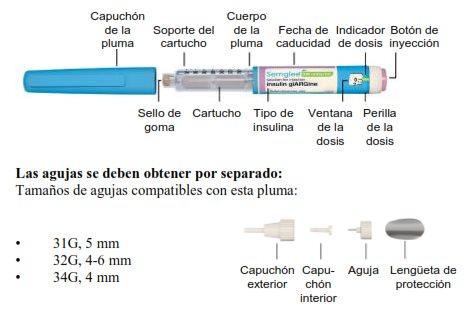
Потрібні матеріали:
Перед тим, як ввінуті свою дозу, переконайтеся, що у вас є наступні речі:
- Піштучка Семглее
- Стерильна голка для ін'єкцій, сумісна з цією піштучкою
- 2 вати з алкоголем
- Контейнер для видалення колючих предметів
Зберігання
Перед тим, як використовувати піштучку вперше, зберігайте упаковки, що містять піштучку, у холодильнику
(2 °C–8 °C).
Незаморожуйте піштучку.
Після того, як ви виймаєте піштучку з холодильника, поставьте її на рівну поверхню та чекайте, поки вона досягне кімнатної температури між 15 °C та 30 °C, перш ніж використовувати її.
Після першого використання піштучки зберігайте її при кімнатній температурі до максимально 30 °C. Не повертайте піштучку до холодильника після використання.
Завжди зберігайте піштучку з ковпачком, щоб уникнути забруднення.
Ви повинні видалити піштучку, яку використовуєте, після 4 тижнів з моменту першого використання, навіть якщо в ній ще залишилося інсуліну. Дивіться крок 8 для отримання інструкцій з видалення.
Незалишайте голку на піштучці під час зберігання та не повторно використовуйте голки. Тримайте піштучку та голки поза зоною видимості та доступу дітей.
Використовуйте завжди нову стерильну голку для кожної ін'єкції, оскільки це запобігає заблокуванню голки та інфекціям.
Кожного разу, коли ви використовуєте піштучку
- Мийте руки водою та мильним засобом перед використанням піштучки.
- Перевіряйте етикетку піштучки, щоб переконатися, що ви ввінуте правильний тип інсуліну. Піштучка має фіолетову та білу етикетку та фіолетовий кнопку ін'єкції.
- Перевіряйте термін придатності на етикетці піштучки. Не використовуйте її після закінчення цього терміну.
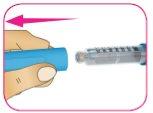
Крок 1. Підготовка піштучки
А - Перевіряйте піштучку: перевірте фіолетову та білу етикетку піштучки, щоб переконатися, що:
- Це правильний тип інсуліну.
- Не закінчився термін придатності.
Б - Тримайте корпус піштучки однією рукою. Зніміть ковпачок з піштучки іншою рукою. Покладіть ковпачок убік для використання пізніше.
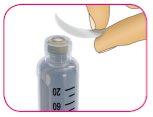
Крок 2. Кріплення нової голки
А - Візьміть нову стерильну голку та зніміть захисний ковпачок. Невикористовуйте голку, якщо захисний ковпачок пошкоджений або відсутній, оскільки голка може бути забруднена.
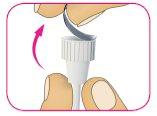
Б - Тримайте корпус голки зверху, встановіть зовнішній ковпачок голки безпосередньо на підтримку картриджа, як показано. Якщо ви спробуєте встановити зовнішній ковпачок голки біч-обіч, голка може загнутися або пошкодитися.
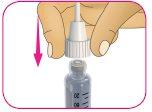
В - Поверніть зовнішній ковпачок голки за годинниковою стрілкою (праворуч) до тих пір, поки не відчуєте, що він щільно закріпився на піштучці.
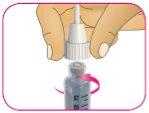
Г - Аккуратно зніміть зовнішній ковпачок голки та покладіть його убік. Не викидайте його, оскільки вам він знадобиться пізніше.
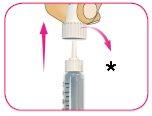
*Збережіть зовнішній ковпачок
Д - Аккуратно зніміть внутрішній ковпачок голки та викиньте його.
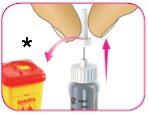
- Викиньте внутрішній ковпачок
Крок 3. Підготовка голки піштучки
А - Завжди готуйте нову голку піштучки перед кожною ін'єкцією.
Б - Поверніть білу ручку дози на 2 одиниці дози. Ви почуєте "клік" за кожну одиницю, яку повертаєте.
Якщо ви повернете ручку дози далі 2 одиниць помилково, поверніть її в протилежному напрямку, щоб виправити кількість одиниць.
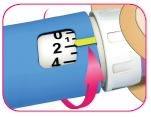
Б - Тримайте корпус піштучки зверху однією рукою.
Г - Стукайте голкою по картриджу, щоб допомогти великим бульбам повітря рухатися до верху картриджа. Можливо, ви все ще побачите малі бульби. Це нормально.
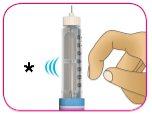
- СТУКАТИ
Д - З піштучкою, що стоїть вертикально, натисніть кнопку ін'єкції до тих пір, поки вона не зупиниться, та вікно дози покаже "0".
Е - Повторюйте кроки 3Б-3Е ще три рази, поки ви не побачите краплі інсуліну на кінчику голки.
Підготовка закінчується, коли ви можете побачити краплі інсуліну.
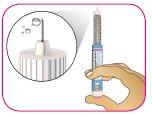
Якщо ви не бачите інсуліну на кінчику голки після 4 спроб підготовки, голка може бути заблокована. Якщо це відбувається:
- Йдіть до кроку 7 для отримання інструкцій щодо безпечного видалення голки.
- Почніть процес знову з кроку 2А для кріплення та підготовки нової голки.
Крок 4. Вибір дози
А - Перевіряйте, що у вікні дози показано "0".
Б - Поверніть білу ручку дози до тих пір, поки жовтий індикатор дози не буде виравнений з бажаною дозою.
Під час того, як ви повертаєте білу ручку дози для регулювання вашої дози, вона розшириться, та ви почуєте "клік" за кожну одиницю.
Дозу можна виправити; для цього потрібно повернути ручку дози в будь-якому напрямку до тих пір, поки правильна доза не буде виравнена з жовтим індикатором дози.

Піштучка не дозволить вам вибрати дозу, яка перевищує кількість одиниць, що залишилися в піштучці. Якщо ваша доза перевищує кількість одиниць, що залишилися в піштучці:
- Ввінуте кількість, що залишилася в піштучці, та використайте нову піштучку для введення решти дози
або
- Візьміть нову піштучку та ввінуте повну дозу.
Непримушуйте ручку дози далі 80 одиниць.
Ненатисніть фіолетову кнопку ін'єкції під час повертання ручки дози.
Крок 5. Вибір та очистка місця ін'єкції
А - Виберіть місце ін'єкції так, як вам пояснив лікар, очистіть цю зону новим ватним тампоном з алкоголем та дайте шкірі висохнути перед ін'єкцією.
Місця ін'єкції включають руки, стегна, сідниці та живіт. Ви повинні змінювати місця ін'єкції для кожної ін'єкції.
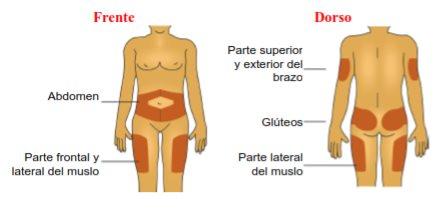
Крок 6. Ін'єкція дози
А - Якщо вам це вказав лікар, ви можете зібрати шкіру між пальцями.
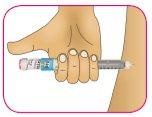
Б - Введіть голку в шкіру прямо, так, як вам вказав лікар.
Неввінуте голку під кутом.
В - Натисніть фіолетову кнопку ін'єкції до кінця. Біля ручка дози повернеться, та ви почуєте "кліки" під час натискання.
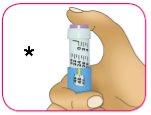
- Натисніть, щоб ввінути
Г - Тримайте натиснуту фіолетову кнопку ін'єкції протягом 10 секунд після того, як у вікні дози з'явиться "0", щоб переконатися, що ввінута вся інсулін. Якщо ви не тримаєте натиснуту кнопку ін'єкції протягом 10 секунд після того, як у вікні дози з'явиться "0", ви можете отримати неправильну дозу лікарського засобу.
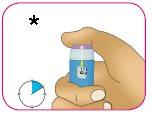
- Тримайте натиснуту протягом 10 секунд
Ненатисніть кнопку ін'єкції біч-обіч чи блокуйте білу ручку дози пальцями, оскільки це завадить вам ввінути лікарський засіб.
Крок 7. Після ін'єкції
А - Візьміть зовнішній ковпачок голки, який ви поклали убік у кроку 2Д, тримайте його за широку частину та акkurатно накрийте голку, не торкаючись її.
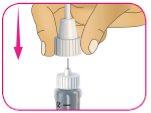
Б - Стисніть широку частину зовнішнього ковпачка голки та поверніть голку проти годинникової стрілки (ліворуч). Продовжуйте повертати голку, поки вона не вийде з піштучки. Можливо, вам потрібно буде зробити кілька поворотів, щоб звільнити голку.
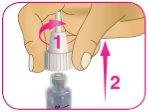
В - Покладіть голку в контейнер для видалення колючих предметів (див. крок 8 для отримання інструкцій з видалення).
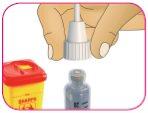
Г - Поверніть ковпачок піштучки на картридж.
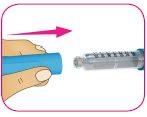
Д - Зберігайте піштучку при кімнатній температурі (до 30 °C). Незберігайте піштучку з використаною голкою.
Крок 8. Видалення
Покладіть використану голку в контейнер для видалення колючих предметів негайно після використання. Невикидайте окремі голки в контейнер для побутових відходів.
Якщо у вас немає контейнера для колючих предметів, ви можете використовувати домашній контейнер, який:
- вироблений з міцного пластику,
- може бути закритий герметичною кришкою, що не пропускає колючі предмети,
- тримається вертикально та стабільно під час використання,
- є герметичним та
- має відповідну маркування, щоб попередити про небезпечні відходи всередині контейнера.
Використану піштучку можна викинути в контейнер для побутових відходів після видалення голки.
Піклування про піштучку
- Всегда носіть з собою попередньо наповнену піштучку з інсуліном, рекомендовану лікарем, на випадок, якщо ваша піштучка загубиться або буде пошкоджена.
- Використовуйте завжди нову голку для кожної ін'єкції, оскільки це запобігає заблокуванню голки та інфекціям.
- Захистіть плуму від прямого сонячного світла, вологи, пилу та місць, де температура може підвищуватися або знижуватися надто сильно (див. розділ про зберігання на початку цих інструкцій).
- Ви можете очистити зовнішню частину плуми вологим рушником.
- Уникайте падіння плуми, оскільки це може викликати розбиття картриджа або пошкодження плуми.
- Непередавайте свою плуму іншим людям, навіть якщо ви змінили голку. Ви можете передати інфекцію іншим людям або заразитися від них.
- Незамочуйте та не миють плуму. Невикористовуйте спирт, пероксид водню, відбілювач або будь-яку іншу рідину для очищення плуми. Ненаносіть змазки, такі як олія. Це може пошкодити плуму.
- Ненамагайтесь ремонтувати пошкоджену плуму. Вийміть голку, як описано в пункті 7, та викиньте плуму або поверніть її до вашого фармацевта. Використовуйте нову плуму замість неї.

Скільки коштує СЕМГЛІ 100 ОД/МЛ розчин для ін'єкцій у попередньо заповненому шприц-ручці в Іспанії у 2025 році?
СЕМГЛІ 100 ОД/МЛ розчин для ін'єкцій у попередньо заповненому шприц-ручці коштує в середньому 56.25 євро у жовтень, 2025 році. Ціна може змінюватися залежно від регіону, аптеки та наявності рецепта. Рекомендуємо перевіряти актуальну вартість у місцевих аптеках або через онлайн-сервіси.
- Країна реєстрації
- Середня ціна в аптеках56.25 EUR
- Діючі речовини
- Потрібен рецептТак
- Виробник
- СкладGLICEROL (85%) (20 mg mg), HIDROXIDO DE SODIO (E 524) (c.s.p. 4.00000000 pH mg)
- Інформація є довідковою і не є медичною порадою. Перед прийомом будь-яких препаратів обов'язково проконсультуйтеся з лікарем. Oladoctor не несе відповідальності за медичні рішення, прийняті на основі цього контенту.
- Альтернативи до СЕМГЛІ 100 ОД/МЛ розчин для ін'єкцій у попередньо заповненому шприц-ручціФорма випуску: РОЗЧИН ДЛЯ ІН'ЄКЦІЙ, 100 ОД/млДіючі речовини: insulin glargineВиробник: Eli Lilly Nederland B.V.Потрібен рецептФорма випуску: РОЗЧИН ДЛЯ ІН'ЄКЦІЙ, НевідомоДіючі речовини: insulin glargineВиробник: Sanofi-Aventis Deutschland GmbhПотрібен рецептФорма випуску: ІН'ЄКЦІЙНИЙ, НевідомоДіючі речовини: insulin glargineВиробник: Sanofi-Aventis Deutschland GmbhПотрібен рецепт


